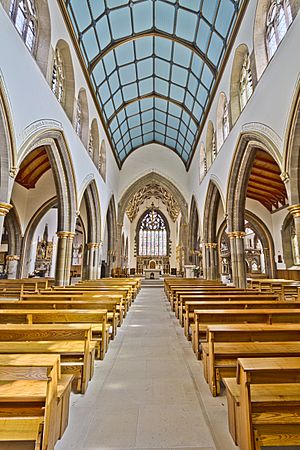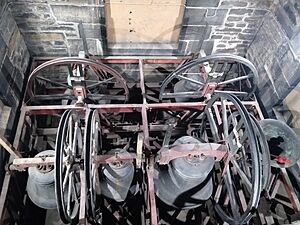Cathedral Church of St Marie, Sheffield facts for kids
Quick facts for kids Cathedral Church of St Marie |
|
|---|---|
| Cathedral Church of St Marie, Sheffield | |
 |
|
| Lua error in Module:Location_map at line 420: attempt to index field 'wikibase' (a nil value). | |
| Location | Sheffield, South Yorkshire |
| Country | England |
| Denomination | Roman Catholic |
| Website | www.stmariecathedral.org |
| History | |
| Consecrated | 1889 |
| Architecture | |
| Architect(s) | Matthew Ellison Hadfield |
| Style | Gothic Revival |
| Years built | 1846-1850 |
| Specifications | |
| Number of spires | 1 |
| Spire height | 195 feet 8 inches (59.6 m) |
| Bells | 8 + Angelus bell (full circle) |
| Tenor bell weight | 25 long cwt 0 qr 4 lb (2,804 lb or 1,272 kg) |
| Administration | |
| Diocese | Hallam (since 1980) |
| Province | Liverpool (since 1911) |
The Cathedral Church of St Marie is a beautiful Roman Catholic cathedral located in Sheffield, England. It is a special church where the main bishop of the area works. You can find it a bit hidden, just off the busy Fargate shopping street.
Even though it's tucked away, you can easily spot it because of its very tall spire. This spire is about 195 feet (59 m) high, making it the tallest in Sheffield! The cathedral is a wonderful example of a Catholic church in England. It has many lovely decorations inside, including old statues and painted tiles.
Contents
History of St Marie's Cathedral
The Church Before St Marie's
Long ago, before the English Reformation, the Church in England was part of the worldwide Roman Catholic Church. Sheffield's main church, St. Peter's (now Sheffield Cathedral), was the most important Catholic church in the area.
In 1534, during the time of King Henry VIII, the Church of England separated from Rome. This meant that Catholic worship became against the law. For many years, Catholics faced difficulties. They could be fined or lose their property. Catholic priests were sometimes hunted down and put in prison.
The powerful Duke of Norfolk family owned much land in Sheffield. They were Catholic, and a special part of St. Peter's church, called the Shrewsbury Chapel, stayed Catholic until 1933. Sometimes, Mass (a Catholic church service) was held secretly in the homes of rich families, like in a house on Fargate that belonged to the Duke of Norfolk. This house even had a secret chapel hidden in its roof!
Building the Church of St Marie
In the late 1700s and early 1800s, laws changed, allowing Catholics to worship more openly. Catholics in Sheffield bought an old house on Fargate. They built a small chapel in its garden. This chapel was on the spot where the Mortuary and Blessed Sacrament Chapels are today.
The names of the priests who served Sheffield before the cathedral was built are written on a wall in the Mortuary Chapel. The rest of the land around the chapel became a cemetery. Later, the bodies from this cemetery were moved to a new Catholic cemetery in Rotherham. Then, work on St Marie's could begin.
By 1846, the small chapel was too small for the growing number of Catholics. A young priest named Fr. Pratt really wanted to build a bigger church. A well-known local architect, Matthew Ellison Hadfield, designed St Marie's. He based his design on a 14th-century church in Heckington, Lincolnshire.
The church was built with expensive decorations. This was possible thanks to generous gifts from the Duke of Norfolk, his mother, and other church members. Sadly, Fr. Pratt died while the church was being built. He was buried in Rotherham. However, a stonemason, who knew Fr. Pratt wanted to be buried at St Marie's, moved his coffin. Fr. Pratt's body is still there, near the altar, and a plaque marks the spot.
St Marie's Opens and Grows
St Marie's was finished in 1850 and opened on September 11. Building the church cost over £10,500. This was a huge amount of money back then, like £1.5 million today! It took until 1889 for the church to pay off all its building debts.
In 1850, Catholic areas called dioceses were set up again in England for the first time since the Protestant Reformation. The Parish of St Marie's, which covered all of Sheffield, became part of the Diocese of Beverley. In 1902, a new house for the priests, now called Cathedral House, was opened.
During the Second World War, a bomb damaged some of the beautiful stained glass windows in the Blessed Sacrament chapel. The remaining windows were taken out and stored in a mine shaft. The mine flooded during the war, and the glass sank into the mud. Even though the original drawings were lost, the windows were still put back in 1947.
In 1970, the church was updated after a big meeting called Vatican II. Dark wooden parts were removed, and new lights and benches were put in. In 1972, a new altar was added. This altar allowed Mass to be celebrated facing the people. The church is a very important historical building, listed as Grade II*, since 1973.
Becoming a Cathedral
On May 30, 1980, a new Catholic area called the diocese of Hallam was created. St. Marie's became the main church for this new diocese, which means it became a cathedral. Bishop Gerald Moverley was the first bishop of Hallam. After he passed away in 1996, Bishop John Rawsthorne became the second bishop.
From September 2011 to November 2012, the cathedral closed for a big renovation project. During this time, the main altar area was made larger and updated. A new special chair for the bishop, called a cathedra, was installed. The choir, who sing during services, moved to the back of the building.
Side chapels and the roof were also repaired. This work even uncovered some original features that had been hidden for years! New heating and toilets were also added. During the renovation, a collection of old Nottingham alabaster carvings was found. Most of these carvings were from the 15th century. They were carefully restored and are now on display in the Cathedral cloisters.
After the cathedral reopened in November 2012, Bishop John Rawsthorne retired. In July 2014, Bishop Ralph Heskett became the third Bishop of Hallam.
Cathedral Bells
St Marie's Cathedral is one of the few Catholic churches that has bells for change ringing. This is a special way of ringing bells in a pattern. The cathedral has eight bells for ringing and an extra bell called an Angelus bell.
The main bells were made by Mears & Stainbank in 1874. The Angelus bell is older, from 1850. Steel bells were first put in the cathedral in 1861, but they were replaced with bronze ones in 1874.
In recent years, the cathedral has become a popular place for visitors. It is also known as a great place for concerts. Many famous choirs from around the world have performed there.
See also
 In Spanish: Catedral de Santa María (Sheffield) para niños
In Spanish: Catedral de Santa María (Sheffield) para niños



